The Effects of School Architecture on Play and Learning for Children
VerifiedAdded on 2022/12/29
|9
|3246
|61
Essay
AI Summary
This essay delves into the significant influence of school architecture on the play and learning experiences of young children. It examines how the design of educational spaces, both interior and exterior, shapes their physical, cognitive, and social development. The essay highlights the importance of creating environments that foster play, encourage exploration, and support holistic learning. It discusses various architectural considerations, such as classroom design, playground facilities, and the integration of natural elements, to create comfortable, safe, and stimulating environments. The essay emphasizes the need for schools to adapt their architectural designs to meet the evolving needs of students and promote their mental health and well-being, particularly by creating spaces that are inclusive, adaptable, and conducive to open communication and personalized learning. The conclusion underscores the critical role of school architecture in creating positive learning environments that support both academic achievement and overall student development.
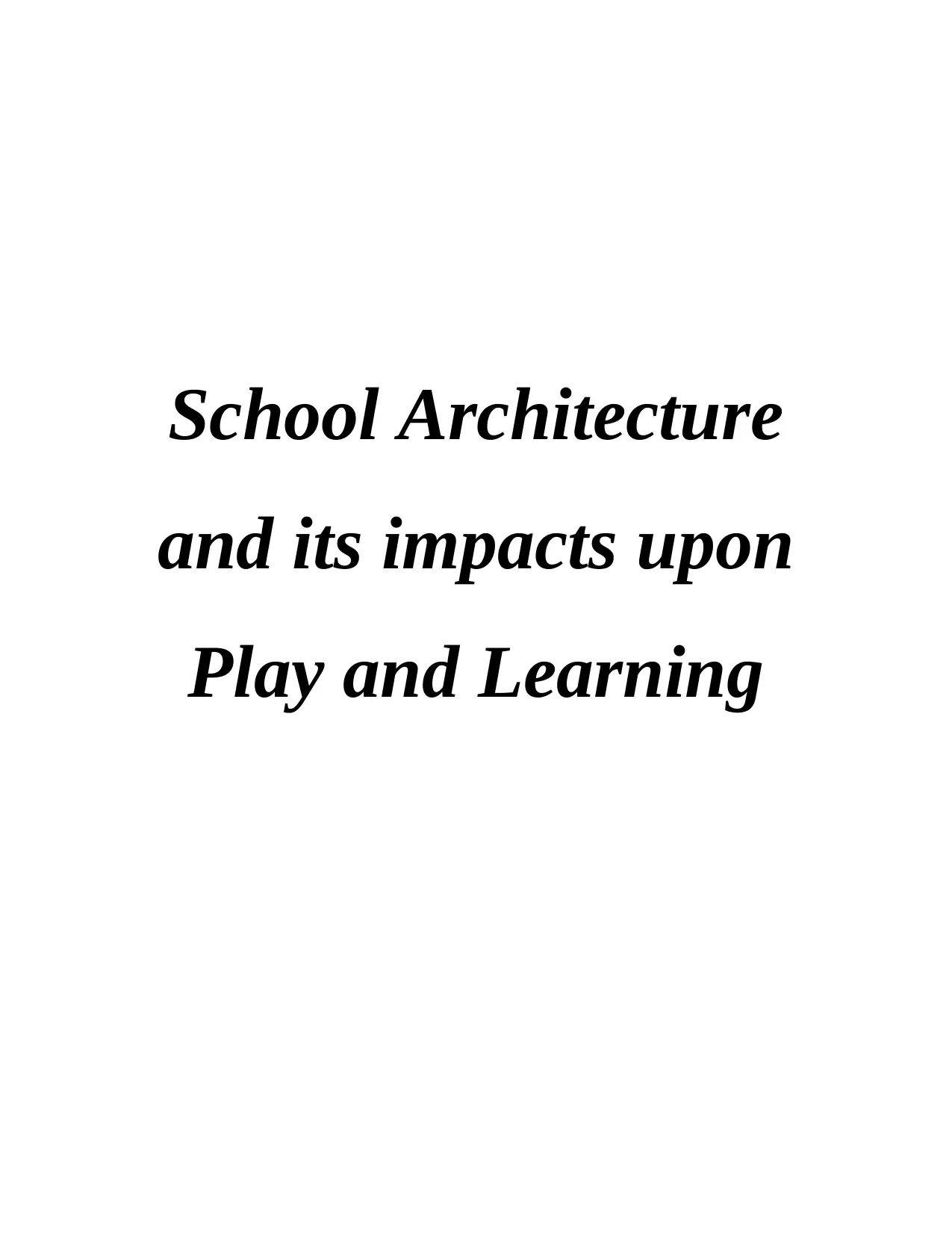
School Architecture
and its impacts upon
Play and Learning
and its impacts upon
Play and Learning
Paraphrase This Document
Need a fresh take? Get an instant paraphrase of this document with our AI Paraphraser
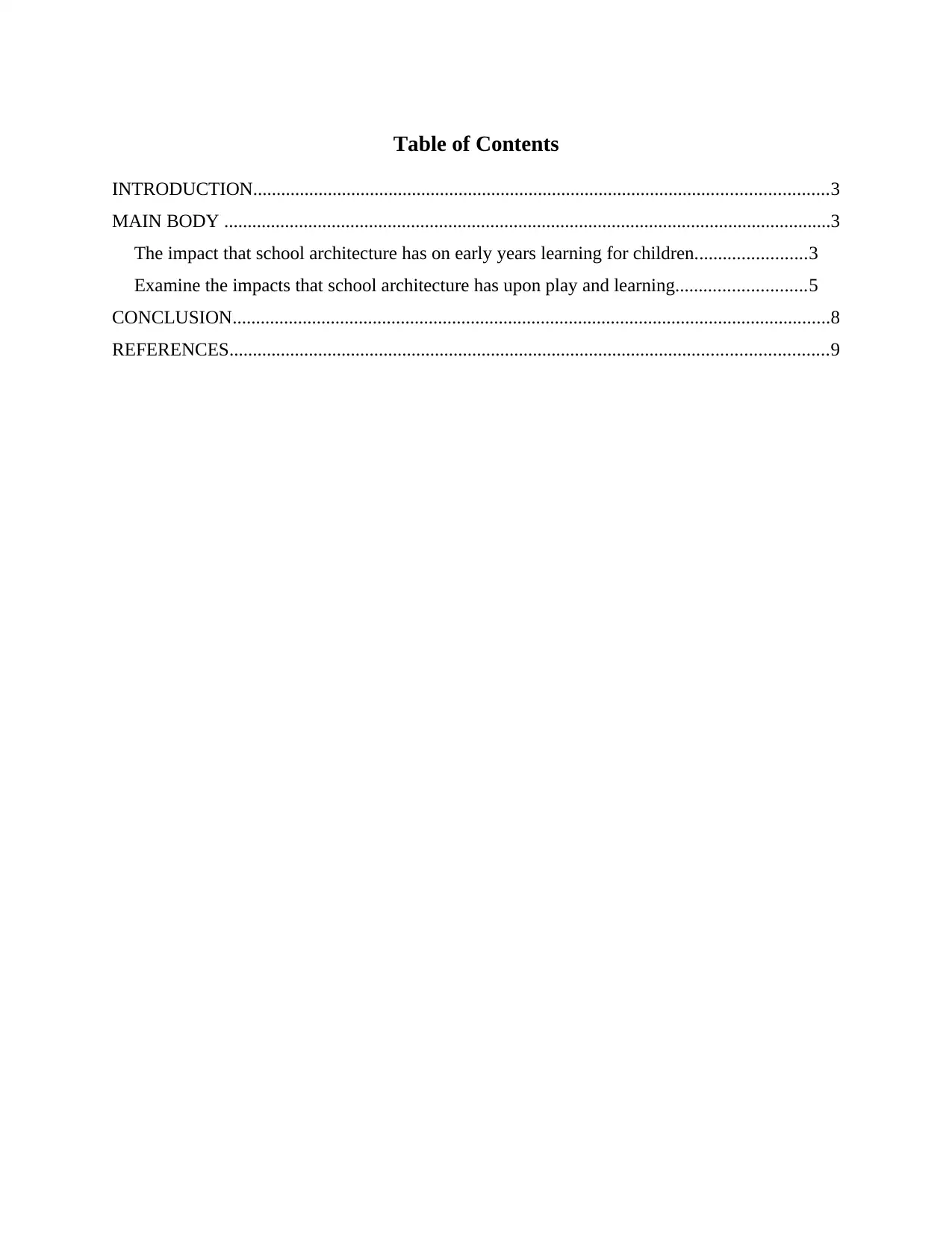
Table of Contents
INTRODUCTION...........................................................................................................................3
MAIN BODY ..................................................................................................................................3
The impact that school architecture has on early years learning for children........................3
Examine the impacts that school architecture has upon play and learning............................5
CONCLUSION................................................................................................................................8
REFERENCES................................................................................................................................9
INTRODUCTION...........................................................................................................................3
MAIN BODY ..................................................................................................................................3
The impact that school architecture has on early years learning for children........................3
Examine the impacts that school architecture has upon play and learning............................5
CONCLUSION................................................................................................................................8
REFERENCES................................................................................................................................9
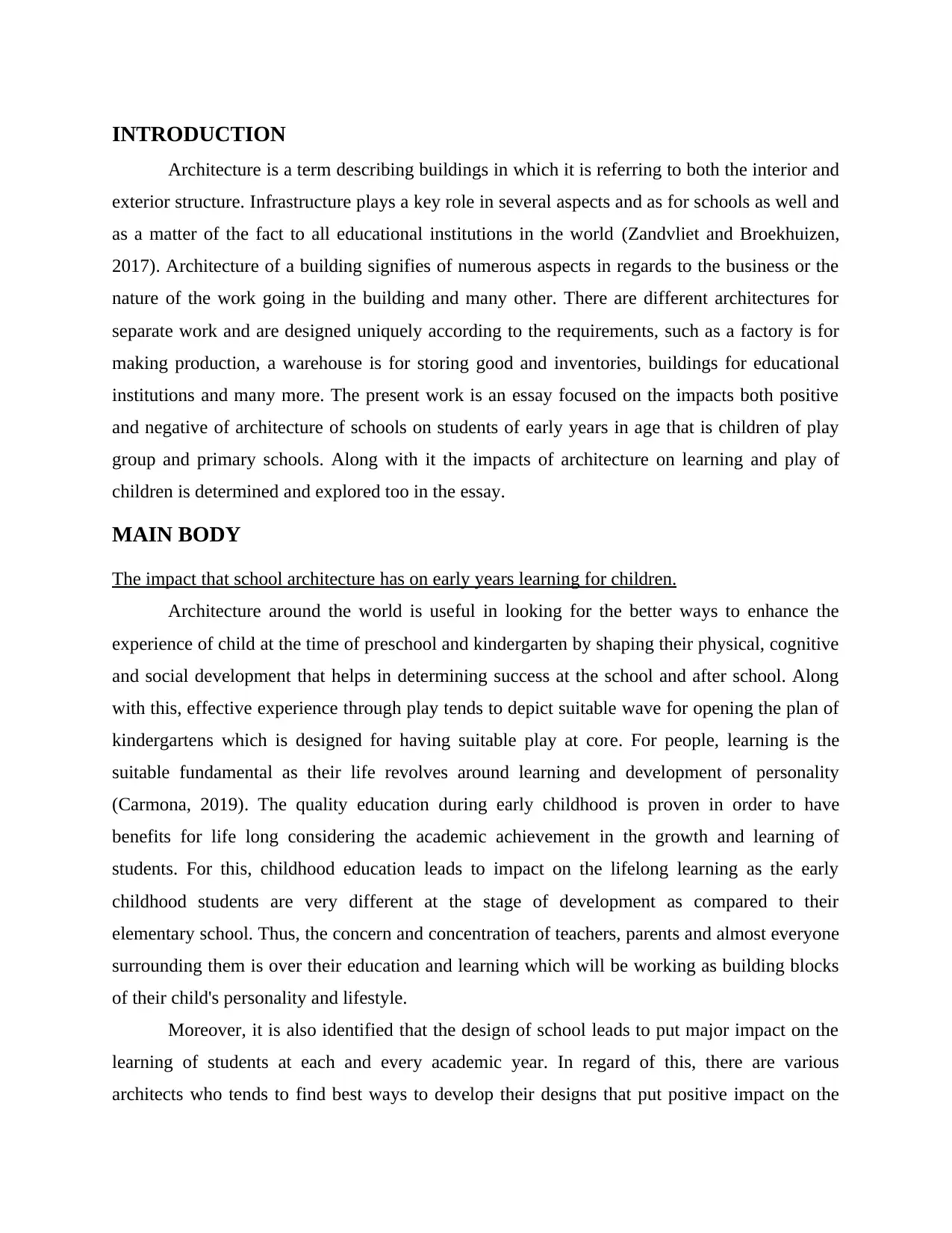
INTRODUCTION
Architecture is a term describing buildings in which it is referring to both the interior and
exterior structure. Infrastructure plays a key role in several aspects and as for schools as well and
as a matter of the fact to all educational institutions in the world (Zandvliet and Broekhuizen,
2017). Architecture of a building signifies of numerous aspects in regards to the business or the
nature of the work going in the building and many other. There are different architectures for
separate work and are designed uniquely according to the requirements, such as a factory is for
making production, a warehouse is for storing good and inventories, buildings for educational
institutions and many more. The present work is an essay focused on the impacts both positive
and negative of architecture of schools on students of early years in age that is children of play
group and primary schools. Along with it the impacts of architecture on learning and play of
children is determined and explored too in the essay.
MAIN BODY
The impact that school architecture has on early years learning for children.
Architecture around the world is useful in looking for the better ways to enhance the
experience of child at the time of preschool and kindergarten by shaping their physical, cognitive
and social development that helps in determining success at the school and after school. Along
with this, effective experience through play tends to depict suitable wave for opening the plan of
kindergartens which is designed for having suitable play at core. For people, learning is the
suitable fundamental as their life revolves around learning and development of personality
(Carmona, 2019). The quality education during early childhood is proven in order to have
benefits for life long considering the academic achievement in the growth and learning of
students. For this, childhood education leads to impact on the lifelong learning as the early
childhood students are very different at the stage of development as compared to their
elementary school. Thus, the concern and concentration of teachers, parents and almost everyone
surrounding them is over their education and learning which will be working as building blocks
of their child's personality and lifestyle.
Moreover, it is also identified that the design of school leads to put major impact on the
learning of students at each and every academic year. In regard of this, there are various
architects who tends to find best ways to develop their designs that put positive impact on the
Architecture is a term describing buildings in which it is referring to both the interior and
exterior structure. Infrastructure plays a key role in several aspects and as for schools as well and
as a matter of the fact to all educational institutions in the world (Zandvliet and Broekhuizen,
2017). Architecture of a building signifies of numerous aspects in regards to the business or the
nature of the work going in the building and many other. There are different architectures for
separate work and are designed uniquely according to the requirements, such as a factory is for
making production, a warehouse is for storing good and inventories, buildings for educational
institutions and many more. The present work is an essay focused on the impacts both positive
and negative of architecture of schools on students of early years in age that is children of play
group and primary schools. Along with it the impacts of architecture on learning and play of
children is determined and explored too in the essay.
MAIN BODY
The impact that school architecture has on early years learning for children.
Architecture around the world is useful in looking for the better ways to enhance the
experience of child at the time of preschool and kindergarten by shaping their physical, cognitive
and social development that helps in determining success at the school and after school. Along
with this, effective experience through play tends to depict suitable wave for opening the plan of
kindergartens which is designed for having suitable play at core. For people, learning is the
suitable fundamental as their life revolves around learning and development of personality
(Carmona, 2019). The quality education during early childhood is proven in order to have
benefits for life long considering the academic achievement in the growth and learning of
students. For this, childhood education leads to impact on the lifelong learning as the early
childhood students are very different at the stage of development as compared to their
elementary school. Thus, the concern and concentration of teachers, parents and almost everyone
surrounding them is over their education and learning which will be working as building blocks
of their child's personality and lifestyle.
Moreover, it is also identified that the design of school leads to put major impact on the
learning of students at each and every academic year. In regard of this, there are various
architects who tends to find best ways to develop their designs that put positive impact on the
⊘ This is a preview!⊘
Do you want full access?
Subscribe today to unlock all pages.

Trusted by 1+ million students worldwide
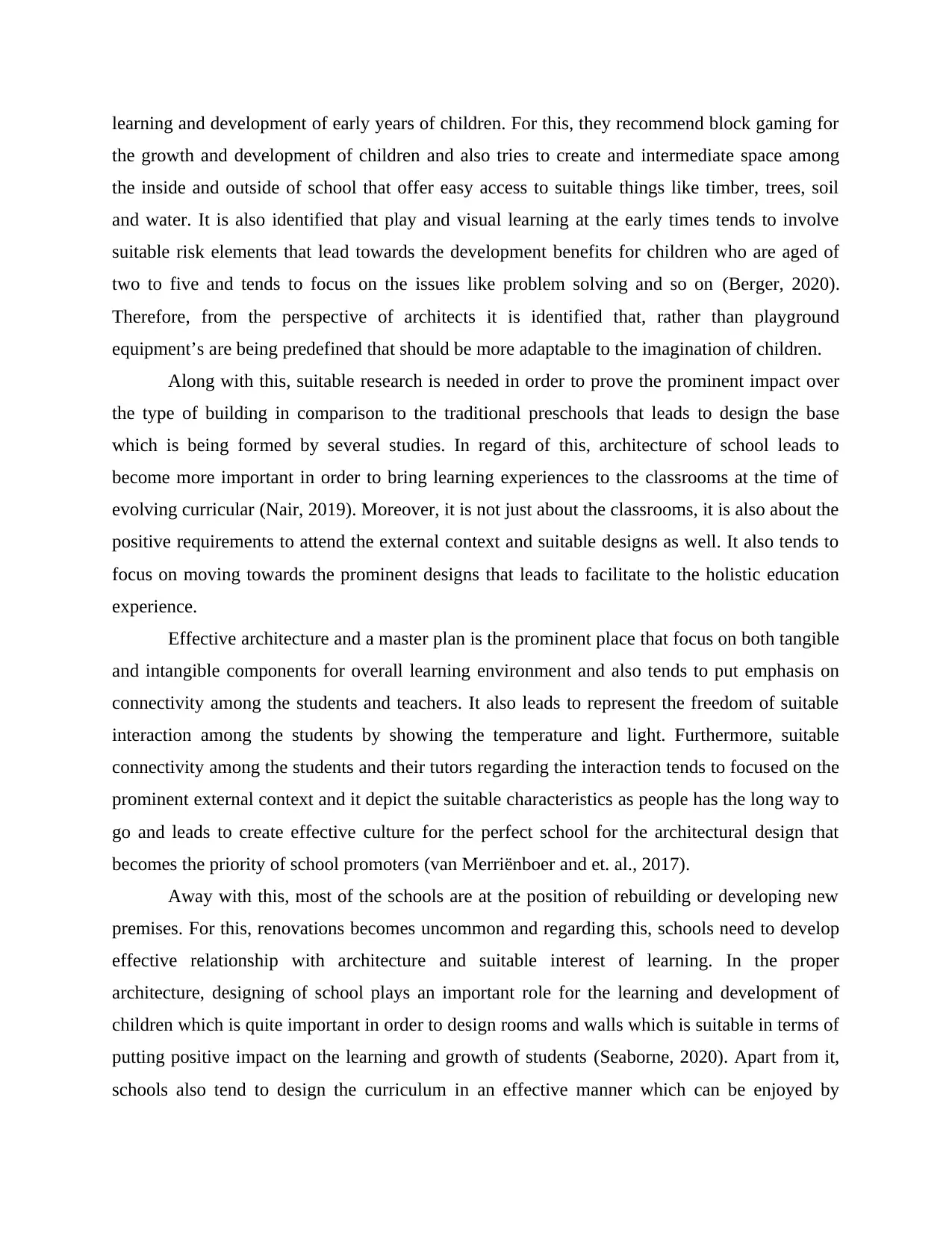
learning and development of early years of children. For this, they recommend block gaming for
the growth and development of children and also tries to create and intermediate space among
the inside and outside of school that offer easy access to suitable things like timber, trees, soil
and water. It is also identified that play and visual learning at the early times tends to involve
suitable risk elements that lead towards the development benefits for children who are aged of
two to five and tends to focus on the issues like problem solving and so on (Berger, 2020).
Therefore, from the perspective of architects it is identified that, rather than playground
equipment’s are being predefined that should be more adaptable to the imagination of children.
Along with this, suitable research is needed in order to prove the prominent impact over
the type of building in comparison to the traditional preschools that leads to design the base
which is being formed by several studies. In regard of this, architecture of school leads to
become more important in order to bring learning experiences to the classrooms at the time of
evolving curricular (Nair, 2019). Moreover, it is not just about the classrooms, it is also about the
positive requirements to attend the external context and suitable designs as well. It also tends to
focus on moving towards the prominent designs that leads to facilitate to the holistic education
experience.
Effective architecture and a master plan is the prominent place that focus on both tangible
and intangible components for overall learning environment and also tends to put emphasis on
connectivity among the students and teachers. It also leads to represent the freedom of suitable
interaction among the students by showing the temperature and light. Furthermore, suitable
connectivity among the students and their tutors regarding the interaction tends to focused on the
prominent external context and it depict the suitable characteristics as people has the long way to
go and leads to create effective culture for the perfect school for the architectural design that
becomes the priority of school promoters (van Merriënboer and et. al., 2017).
Away with this, most of the schools are at the position of rebuilding or developing new
premises. For this, renovations becomes uncommon and regarding this, schools need to develop
effective relationship with architecture and suitable interest of learning. In the proper
architecture, designing of school plays an important role for the learning and development of
children which is quite important in order to design rooms and walls which is suitable in terms of
putting positive impact on the learning and growth of students (Seaborne, 2020). Apart from it,
schools also tend to design the curriculum in an effective manner which can be enjoyed by
the growth and development of children and also tries to create and intermediate space among
the inside and outside of school that offer easy access to suitable things like timber, trees, soil
and water. It is also identified that play and visual learning at the early times tends to involve
suitable risk elements that lead towards the development benefits for children who are aged of
two to five and tends to focus on the issues like problem solving and so on (Berger, 2020).
Therefore, from the perspective of architects it is identified that, rather than playground
equipment’s are being predefined that should be more adaptable to the imagination of children.
Along with this, suitable research is needed in order to prove the prominent impact over
the type of building in comparison to the traditional preschools that leads to design the base
which is being formed by several studies. In regard of this, architecture of school leads to
become more important in order to bring learning experiences to the classrooms at the time of
evolving curricular (Nair, 2019). Moreover, it is not just about the classrooms, it is also about the
positive requirements to attend the external context and suitable designs as well. It also tends to
focus on moving towards the prominent designs that leads to facilitate to the holistic education
experience.
Effective architecture and a master plan is the prominent place that focus on both tangible
and intangible components for overall learning environment and also tends to put emphasis on
connectivity among the students and teachers. It also leads to represent the freedom of suitable
interaction among the students by showing the temperature and light. Furthermore, suitable
connectivity among the students and their tutors regarding the interaction tends to focused on the
prominent external context and it depict the suitable characteristics as people has the long way to
go and leads to create effective culture for the perfect school for the architectural design that
becomes the priority of school promoters (van Merriënboer and et. al., 2017).
Away with this, most of the schools are at the position of rebuilding or developing new
premises. For this, renovations becomes uncommon and regarding this, schools need to develop
effective relationship with architecture and suitable interest of learning. In the proper
architecture, designing of school plays an important role for the learning and development of
children which is quite important in order to design rooms and walls which is suitable in terms of
putting positive impact on the learning and growth of students (Seaborne, 2020). Apart from it,
schools also tend to design the curriculum in an effective manner which can be enjoyed by
Paraphrase This Document
Need a fresh take? Get an instant paraphrase of this document with our AI Paraphraser
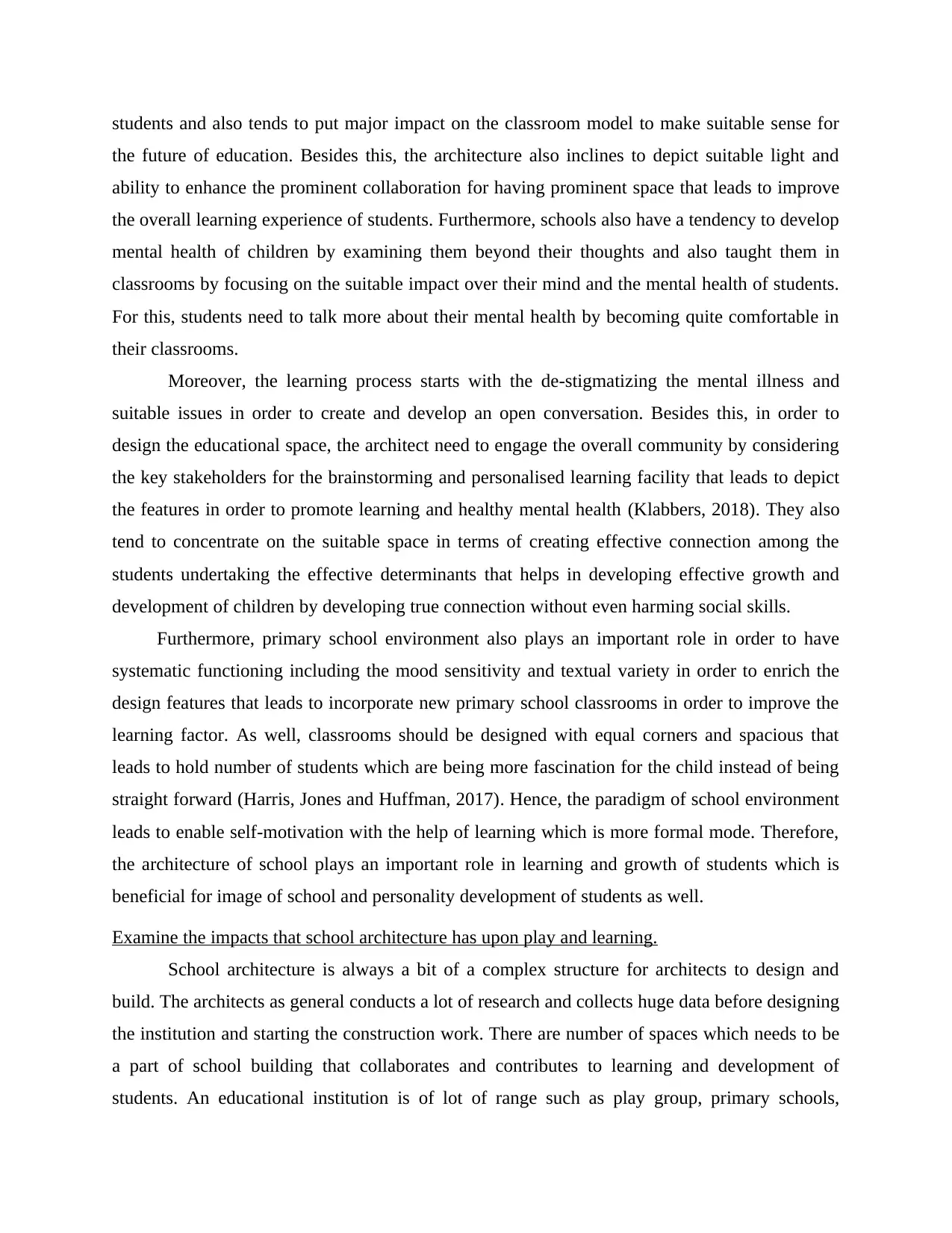
students and also tends to put major impact on the classroom model to make suitable sense for
the future of education. Besides this, the architecture also inclines to depict suitable light and
ability to enhance the prominent collaboration for having prominent space that leads to improve
the overall learning experience of students. Furthermore, schools also have a tendency to develop
mental health of children by examining them beyond their thoughts and also taught them in
classrooms by focusing on the suitable impact over their mind and the mental health of students.
For this, students need to talk more about their mental health by becoming quite comfortable in
their classrooms.
Moreover, the learning process starts with the de-stigmatizing the mental illness and
suitable issues in order to create and develop an open conversation. Besides this, in order to
design the educational space, the architect need to engage the overall community by considering
the key stakeholders for the brainstorming and personalised learning facility that leads to depict
the features in order to promote learning and healthy mental health (Klabbers, 2018). They also
tend to concentrate on the suitable space in terms of creating effective connection among the
students undertaking the effective determinants that helps in developing effective growth and
development of children by developing true connection without even harming social skills.
Furthermore, primary school environment also plays an important role in order to have
systematic functioning including the mood sensitivity and textual variety in order to enrich the
design features that leads to incorporate new primary school classrooms in order to improve the
learning factor. As well, classrooms should be designed with equal corners and spacious that
leads to hold number of students which are being more fascination for the child instead of being
straight forward (Harris, Jones and Huffman, 2017). Hence, the paradigm of school environment
leads to enable self-motivation with the help of learning which is more formal mode. Therefore,
the architecture of school plays an important role in learning and growth of students which is
beneficial for image of school and personality development of students as well.
Examine the impacts that school architecture has upon play and learning.
School architecture is always a bit of a complex structure for architects to design and
build. The architects as general conducts a lot of research and collects huge data before designing
the institution and starting the construction work. There are number of spaces which needs to be
a part of school building that collaborates and contributes to learning and development of
students. An educational institution is of lot of range such as play group, primary schools,
the future of education. Besides this, the architecture also inclines to depict suitable light and
ability to enhance the prominent collaboration for having prominent space that leads to improve
the overall learning experience of students. Furthermore, schools also have a tendency to develop
mental health of children by examining them beyond their thoughts and also taught them in
classrooms by focusing on the suitable impact over their mind and the mental health of students.
For this, students need to talk more about their mental health by becoming quite comfortable in
their classrooms.
Moreover, the learning process starts with the de-stigmatizing the mental illness and
suitable issues in order to create and develop an open conversation. Besides this, in order to
design the educational space, the architect need to engage the overall community by considering
the key stakeholders for the brainstorming and personalised learning facility that leads to depict
the features in order to promote learning and healthy mental health (Klabbers, 2018). They also
tend to concentrate on the suitable space in terms of creating effective connection among the
students undertaking the effective determinants that helps in developing effective growth and
development of children by developing true connection without even harming social skills.
Furthermore, primary school environment also plays an important role in order to have
systematic functioning including the mood sensitivity and textual variety in order to enrich the
design features that leads to incorporate new primary school classrooms in order to improve the
learning factor. As well, classrooms should be designed with equal corners and spacious that
leads to hold number of students which are being more fascination for the child instead of being
straight forward (Harris, Jones and Huffman, 2017). Hence, the paradigm of school environment
leads to enable self-motivation with the help of learning which is more formal mode. Therefore,
the architecture of school plays an important role in learning and growth of students which is
beneficial for image of school and personality development of students as well.
Examine the impacts that school architecture has upon play and learning.
School architecture is always a bit of a complex structure for architects to design and
build. The architects as general conducts a lot of research and collects huge data before designing
the institution and starting the construction work. There are number of spaces which needs to be
a part of school building that collaborates and contributes to learning and development of
students. An educational institution is of lot of range such as play group, primary schools,
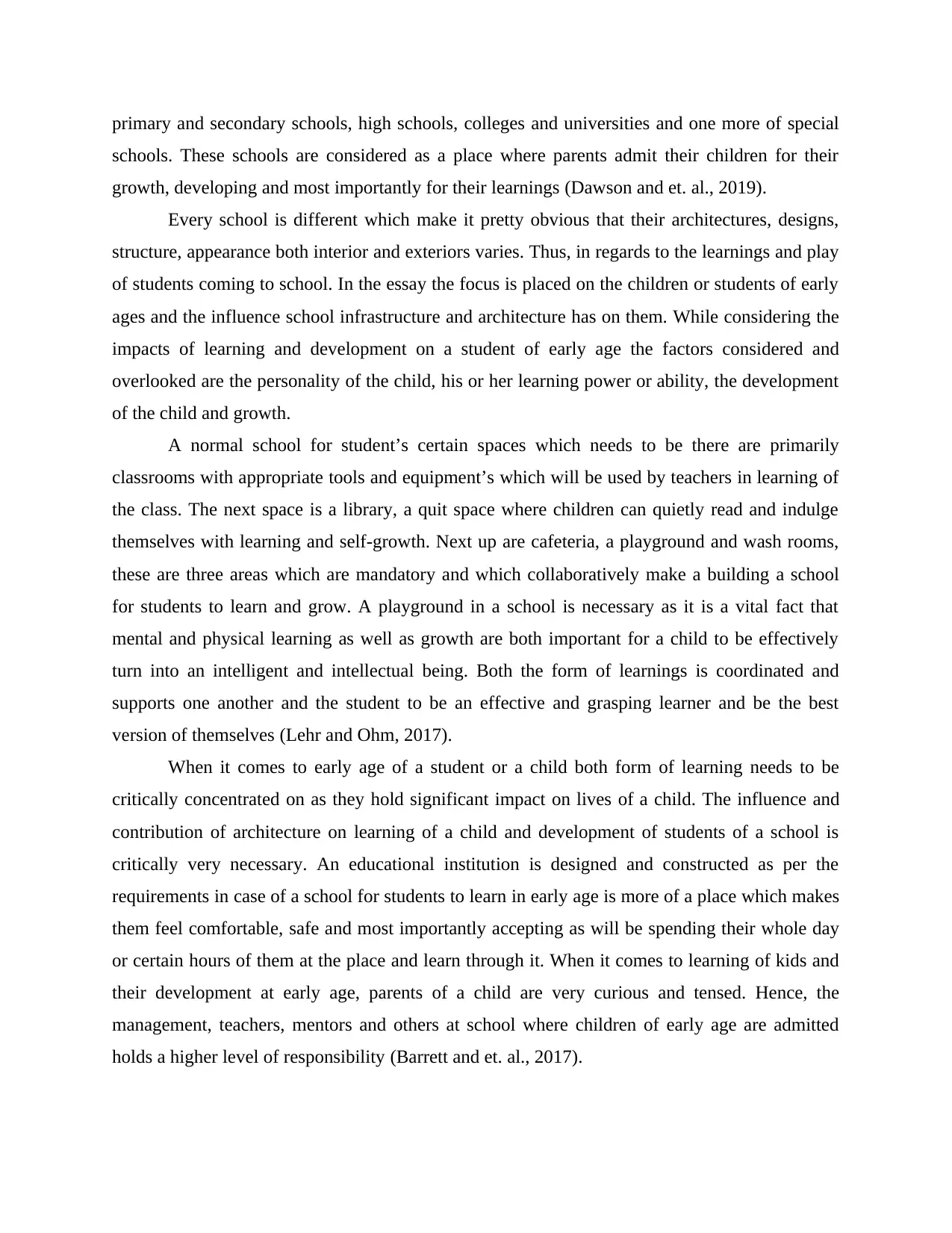
primary and secondary schools, high schools, colleges and universities and one more of special
schools. These schools are considered as a place where parents admit their children for their
growth, developing and most importantly for their learnings (Dawson and et. al., 2019).
Every school is different which make it pretty obvious that their architectures, designs,
structure, appearance both interior and exteriors varies. Thus, in regards to the learnings and play
of students coming to school. In the essay the focus is placed on the children or students of early
ages and the influence school infrastructure and architecture has on them. While considering the
impacts of learning and development on a student of early age the factors considered and
overlooked are the personality of the child, his or her learning power or ability, the development
of the child and growth.
A normal school for student’s certain spaces which needs to be there are primarily
classrooms with appropriate tools and equipment’s which will be used by teachers in learning of
the class. The next space is a library, a quit space where children can quietly read and indulge
themselves with learning and self-growth. Next up are cafeteria, a playground and wash rooms,
these are three areas which are mandatory and which collaboratively make a building a school
for students to learn and grow. A playground in a school is necessary as it is a vital fact that
mental and physical learning as well as growth are both important for a child to be effectively
turn into an intelligent and intellectual being. Both the form of learnings is coordinated and
supports one another and the student to be an effective and grasping learner and be the best
version of themselves (Lehr and Ohm, 2017).
When it comes to early age of a student or a child both form of learning needs to be
critically concentrated on as they hold significant impact on lives of a child. The influence and
contribution of architecture on learning of a child and development of students of a school is
critically very necessary. An educational institution is designed and constructed as per the
requirements in case of a school for students to learn in early age is more of a place which makes
them feel comfortable, safe and most importantly accepting as will be spending their whole day
or certain hours of them at the place and learn through it. When it comes to learning of kids and
their development at early age, parents of a child are very curious and tensed. Hence, the
management, teachers, mentors and others at school where children of early age are admitted
holds a higher level of responsibility (Barrett and et. al., 2017).
schools. These schools are considered as a place where parents admit their children for their
growth, developing and most importantly for their learnings (Dawson and et. al., 2019).
Every school is different which make it pretty obvious that their architectures, designs,
structure, appearance both interior and exteriors varies. Thus, in regards to the learnings and play
of students coming to school. In the essay the focus is placed on the children or students of early
ages and the influence school infrastructure and architecture has on them. While considering the
impacts of learning and development on a student of early age the factors considered and
overlooked are the personality of the child, his or her learning power or ability, the development
of the child and growth.
A normal school for student’s certain spaces which needs to be there are primarily
classrooms with appropriate tools and equipment’s which will be used by teachers in learning of
the class. The next space is a library, a quit space where children can quietly read and indulge
themselves with learning and self-growth. Next up are cafeteria, a playground and wash rooms,
these are three areas which are mandatory and which collaboratively make a building a school
for students to learn and grow. A playground in a school is necessary as it is a vital fact that
mental and physical learning as well as growth are both important for a child to be effectively
turn into an intelligent and intellectual being. Both the form of learnings is coordinated and
supports one another and the student to be an effective and grasping learner and be the best
version of themselves (Lehr and Ohm, 2017).
When it comes to early age of a student or a child both form of learning needs to be
critically concentrated on as they hold significant impact on lives of a child. The influence and
contribution of architecture on learning of a child and development of students of a school is
critically very necessary. An educational institution is designed and constructed as per the
requirements in case of a school for students to learn in early age is more of a place which makes
them feel comfortable, safe and most importantly accepting as will be spending their whole day
or certain hours of them at the place and learn through it. When it comes to learning of kids and
their development at early age, parents of a child are very curious and tensed. Hence, the
management, teachers, mentors and others at school where children of early age are admitted
holds a higher level of responsibility (Barrett and et. al., 2017).
⊘ This is a preview!⊘
Do you want full access?
Subscribe today to unlock all pages.

Trusted by 1+ million students worldwide
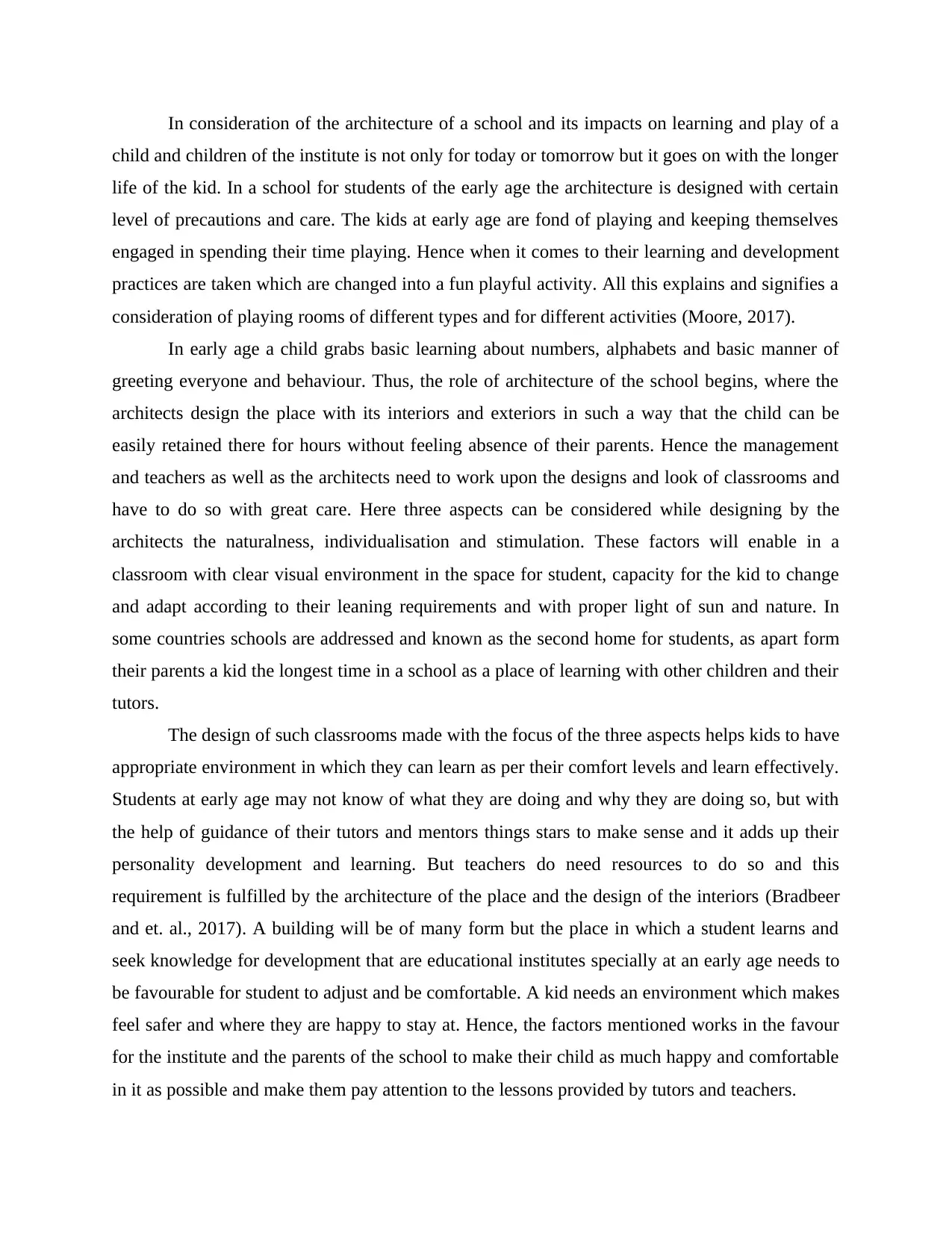
In consideration of the architecture of a school and its impacts on learning and play of a
child and children of the institute is not only for today or tomorrow but it goes on with the longer
life of the kid. In a school for students of the early age the architecture is designed with certain
level of precautions and care. The kids at early age are fond of playing and keeping themselves
engaged in spending their time playing. Hence when it comes to their learning and development
practices are taken which are changed into a fun playful activity. All this explains and signifies a
consideration of playing rooms of different types and for different activities (Moore, 2017).
In early age a child grabs basic learning about numbers, alphabets and basic manner of
greeting everyone and behaviour. Thus, the role of architecture of the school begins, where the
architects design the place with its interiors and exteriors in such a way that the child can be
easily retained there for hours without feeling absence of their parents. Hence the management
and teachers as well as the architects need to work upon the designs and look of classrooms and
have to do so with great care. Here three aspects can be considered while designing by the
architects the naturalness, individualisation and stimulation. These factors will enable in a
classroom with clear visual environment in the space for student, capacity for the kid to change
and adapt according to their leaning requirements and with proper light of sun and nature. In
some countries schools are addressed and known as the second home for students, as apart form
their parents a kid the longest time in a school as a place of learning with other children and their
tutors.
The design of such classrooms made with the focus of the three aspects helps kids to have
appropriate environment in which they can learn as per their comfort levels and learn effectively.
Students at early age may not know of what they are doing and why they are doing so, but with
the help of guidance of their tutors and mentors things stars to make sense and it adds up their
personality development and learning. But teachers do need resources to do so and this
requirement is fulfilled by the architecture of the place and the design of the interiors (Bradbeer
and et. al., 2017). A building will be of many form but the place in which a student learns and
seek knowledge for development that are educational institutes specially at an early age needs to
be favourable for student to adjust and be comfortable. A kid needs an environment which makes
feel safer and where they are happy to stay at. Hence, the factors mentioned works in the favour
for the institute and the parents of the school to make their child as much happy and comfortable
in it as possible and make them pay attention to the lessons provided by tutors and teachers.
child and children of the institute is not only for today or tomorrow but it goes on with the longer
life of the kid. In a school for students of the early age the architecture is designed with certain
level of precautions and care. The kids at early age are fond of playing and keeping themselves
engaged in spending their time playing. Hence when it comes to their learning and development
practices are taken which are changed into a fun playful activity. All this explains and signifies a
consideration of playing rooms of different types and for different activities (Moore, 2017).
In early age a child grabs basic learning about numbers, alphabets and basic manner of
greeting everyone and behaviour. Thus, the role of architecture of the school begins, where the
architects design the place with its interiors and exteriors in such a way that the child can be
easily retained there for hours without feeling absence of their parents. Hence the management
and teachers as well as the architects need to work upon the designs and look of classrooms and
have to do so with great care. Here three aspects can be considered while designing by the
architects the naturalness, individualisation and stimulation. These factors will enable in a
classroom with clear visual environment in the space for student, capacity for the kid to change
and adapt according to their leaning requirements and with proper light of sun and nature. In
some countries schools are addressed and known as the second home for students, as apart form
their parents a kid the longest time in a school as a place of learning with other children and their
tutors.
The design of such classrooms made with the focus of the three aspects helps kids to have
appropriate environment in which they can learn as per their comfort levels and learn effectively.
Students at early age may not know of what they are doing and why they are doing so, but with
the help of guidance of their tutors and mentors things stars to make sense and it adds up their
personality development and learning. But teachers do need resources to do so and this
requirement is fulfilled by the architecture of the place and the design of the interiors (Bradbeer
and et. al., 2017). A building will be of many form but the place in which a student learns and
seek knowledge for development that are educational institutes specially at an early age needs to
be favourable for student to adjust and be comfortable. A kid needs an environment which makes
feel safer and where they are happy to stay at. Hence, the factors mentioned works in the favour
for the institute and the parents of the school to make their child as much happy and comfortable
in it as possible and make them pay attention to the lessons provided by tutors and teachers.
Paraphrase This Document
Need a fresh take? Get an instant paraphrase of this document with our AI Paraphraser
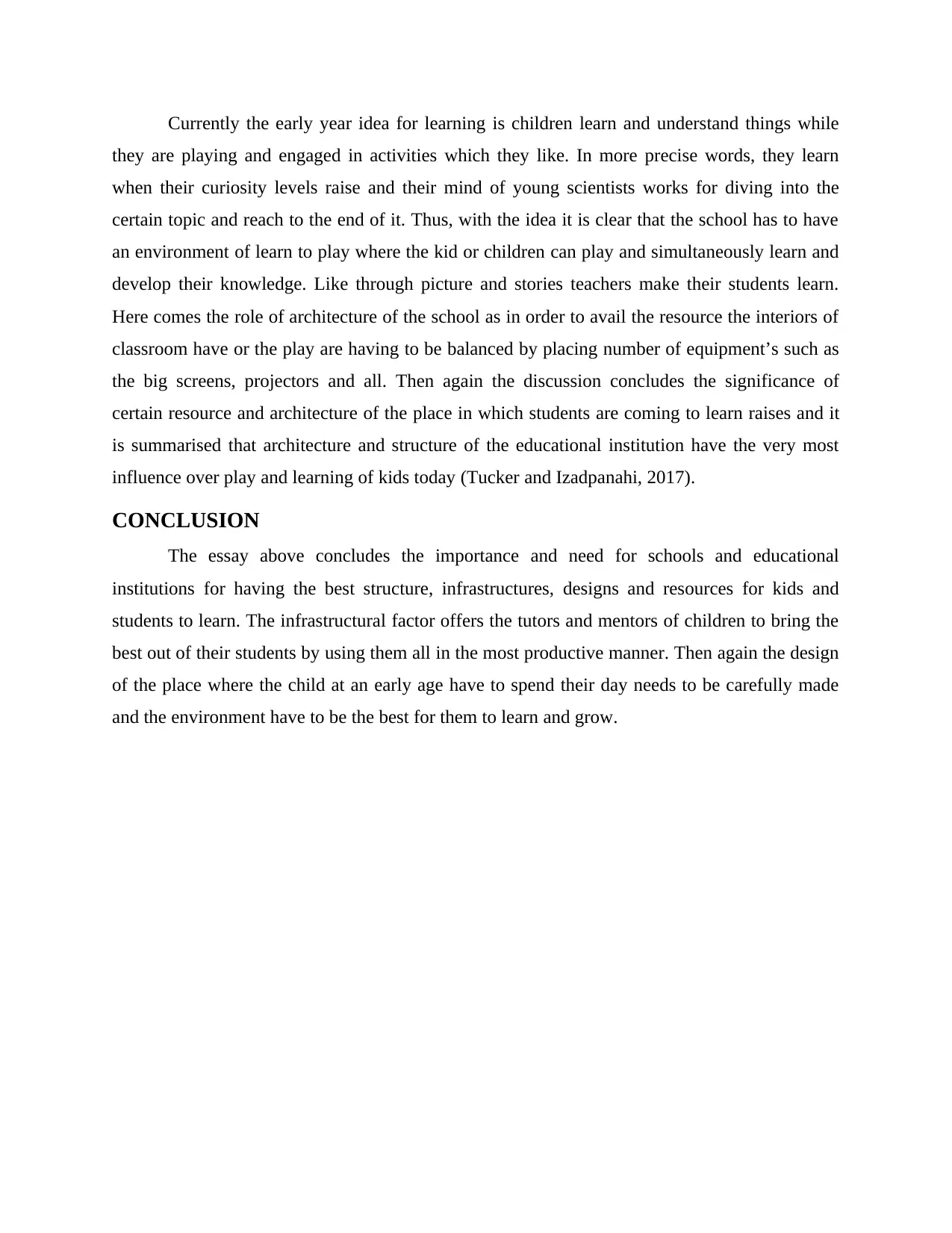
Currently the early year idea for learning is children learn and understand things while
they are playing and engaged in activities which they like. In more precise words, they learn
when their curiosity levels raise and their mind of young scientists works for diving into the
certain topic and reach to the end of it. Thus, with the idea it is clear that the school has to have
an environment of learn to play where the kid or children can play and simultaneously learn and
develop their knowledge. Like through picture and stories teachers make their students learn.
Here comes the role of architecture of the school as in order to avail the resource the interiors of
classroom have or the play are having to be balanced by placing number of equipment’s such as
the big screens, projectors and all. Then again the discussion concludes the significance of
certain resource and architecture of the place in which students are coming to learn raises and it
is summarised that architecture and structure of the educational institution have the very most
influence over play and learning of kids today (Tucker and Izadpanahi, 2017).
CONCLUSION
The essay above concludes the importance and need for schools and educational
institutions for having the best structure, infrastructures, designs and resources for kids and
students to learn. The infrastructural factor offers the tutors and mentors of children to bring the
best out of their students by using them all in the most productive manner. Then again the design
of the place where the child at an early age have to spend their day needs to be carefully made
and the environment have to be the best for them to learn and grow.
they are playing and engaged in activities which they like. In more precise words, they learn
when their curiosity levels raise and their mind of young scientists works for diving into the
certain topic and reach to the end of it. Thus, with the idea it is clear that the school has to have
an environment of learn to play where the kid or children can play and simultaneously learn and
develop their knowledge. Like through picture and stories teachers make their students learn.
Here comes the role of architecture of the school as in order to avail the resource the interiors of
classroom have or the play are having to be balanced by placing number of equipment’s such as
the big screens, projectors and all. Then again the discussion concludes the significance of
certain resource and architecture of the place in which students are coming to learn raises and it
is summarised that architecture and structure of the educational institution have the very most
influence over play and learning of kids today (Tucker and Izadpanahi, 2017).
CONCLUSION
The essay above concludes the importance and need for schools and educational
institutions for having the best structure, infrastructures, designs and resources for kids and
students to learn. The infrastructural factor offers the tutors and mentors of children to bring the
best out of their students by using them all in the most productive manner. Then again the design
of the place where the child at an early age have to spend their day needs to be carefully made
and the environment have to be the best for them to learn and grow.
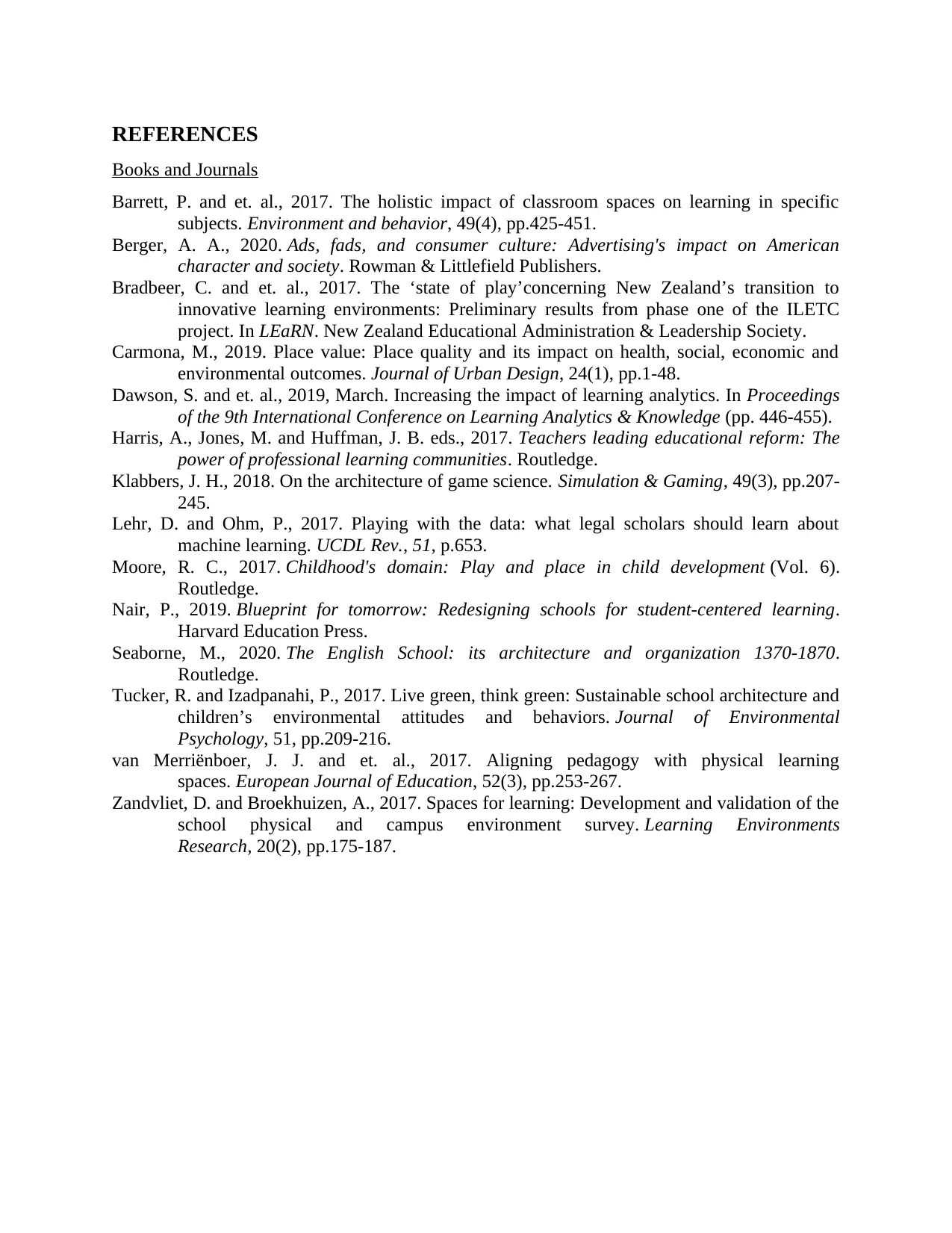
REFERENCES
Books and Journals
Barrett, P. and et. al., 2017. The holistic impact of classroom spaces on learning in specific
subjects. Environment and behavior, 49(4), pp.425-451.
Berger, A. A., 2020. Ads, fads, and consumer culture: Advertising's impact on American
character and society. Rowman & Littlefield Publishers.
Bradbeer, C. and et. al., 2017. The ‘state of play’concerning New Zealand’s transition to
innovative learning environments: Preliminary results from phase one of the ILETC
project. In LEaRN. New Zealand Educational Administration & Leadership Society.
Carmona, M., 2019. Place value: Place quality and its impact on health, social, economic and
environmental outcomes. Journal of Urban Design, 24(1), pp.1-48.
Dawson, S. and et. al., 2019, March. Increasing the impact of learning analytics. In Proceedings
of the 9th International Conference on Learning Analytics & Knowledge (pp. 446-455).
Harris, A., Jones, M. and Huffman, J. B. eds., 2017. Teachers leading educational reform: The
power of professional learning communities. Routledge.
Klabbers, J. H., 2018. On the architecture of game science. Simulation & Gaming, 49(3), pp.207-
245.
Lehr, D. and Ohm, P., 2017. Playing with the data: what legal scholars should learn about
machine learning. UCDL Rev., 51, p.653.
Moore, R. C., 2017. Childhood's domain: Play and place in child development (Vol. 6).
Routledge.
Nair, P., 2019. Blueprint for tomorrow: Redesigning schools for student-centered learning.
Harvard Education Press.
Seaborne, M., 2020. The English School: its architecture and organization 1370-1870.
Routledge.
Tucker, R. and Izadpanahi, P., 2017. Live green, think green: Sustainable school architecture and
children’s environmental attitudes and behaviors. Journal of Environmental
Psychology, 51, pp.209-216.
van Merriënboer, J. J. and et. al., 2017. Aligning pedagogy with physical learning
spaces. European Journal of Education, 52(3), pp.253-267.
Zandvliet, D. and Broekhuizen, A., 2017. Spaces for learning: Development and validation of the
school physical and campus environment survey. Learning Environments
Research, 20(2), pp.175-187.
Books and Journals
Barrett, P. and et. al., 2017. The holistic impact of classroom spaces on learning in specific
subjects. Environment and behavior, 49(4), pp.425-451.
Berger, A. A., 2020. Ads, fads, and consumer culture: Advertising's impact on American
character and society. Rowman & Littlefield Publishers.
Bradbeer, C. and et. al., 2017. The ‘state of play’concerning New Zealand’s transition to
innovative learning environments: Preliminary results from phase one of the ILETC
project. In LEaRN. New Zealand Educational Administration & Leadership Society.
Carmona, M., 2019. Place value: Place quality and its impact on health, social, economic and
environmental outcomes. Journal of Urban Design, 24(1), pp.1-48.
Dawson, S. and et. al., 2019, March. Increasing the impact of learning analytics. In Proceedings
of the 9th International Conference on Learning Analytics & Knowledge (pp. 446-455).
Harris, A., Jones, M. and Huffman, J. B. eds., 2017. Teachers leading educational reform: The
power of professional learning communities. Routledge.
Klabbers, J. H., 2018. On the architecture of game science. Simulation & Gaming, 49(3), pp.207-
245.
Lehr, D. and Ohm, P., 2017. Playing with the data: what legal scholars should learn about
machine learning. UCDL Rev., 51, p.653.
Moore, R. C., 2017. Childhood's domain: Play and place in child development (Vol. 6).
Routledge.
Nair, P., 2019. Blueprint for tomorrow: Redesigning schools for student-centered learning.
Harvard Education Press.
Seaborne, M., 2020. The English School: its architecture and organization 1370-1870.
Routledge.
Tucker, R. and Izadpanahi, P., 2017. Live green, think green: Sustainable school architecture and
children’s environmental attitudes and behaviors. Journal of Environmental
Psychology, 51, pp.209-216.
van Merriënboer, J. J. and et. al., 2017. Aligning pedagogy with physical learning
spaces. European Journal of Education, 52(3), pp.253-267.
Zandvliet, D. and Broekhuizen, A., 2017. Spaces for learning: Development and validation of the
school physical and campus environment survey. Learning Environments
Research, 20(2), pp.175-187.
⊘ This is a preview!⊘
Do you want full access?
Subscribe today to unlock all pages.

Trusted by 1+ million students worldwide
1 out of 9
Related Documents
Your All-in-One AI-Powered Toolkit for Academic Success.
+13062052269
info@desklib.com
Available 24*7 on WhatsApp / Email
![[object Object]](/_next/static/media/star-bottom.7253800d.svg)
Unlock your academic potential
Copyright © 2020–2025 A2Z Services. All Rights Reserved. Developed and managed by ZUCOL.




